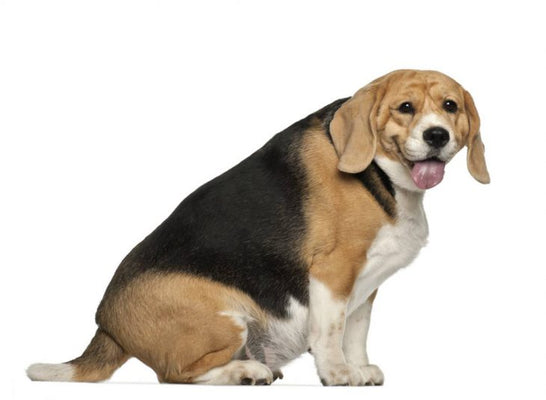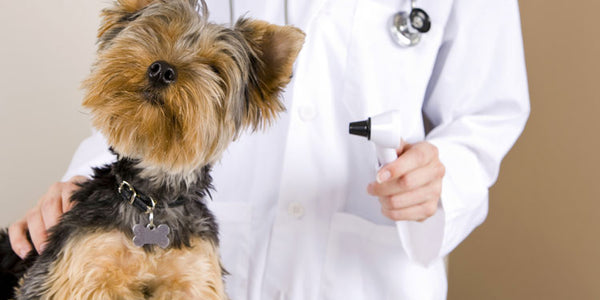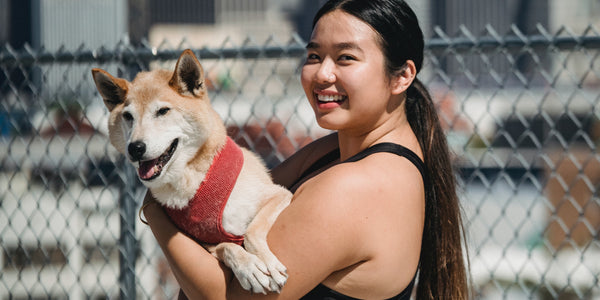Having an overweight dog and the growing concerns about pet obesity is a problem that is widespread, but is also equally widely denied. Somehow, many pet owners simply don’t think it is a big problem if their dog is overweight, and believe it is exaggeration to call a little chubbiness ‘obesity’.
However, the harsh truth is that dog obesity is not only very real, but also extremely harmful. No, you’re not the only one who needs to eat right, work out and maintain an ideal weight; your dog has the same needs!
Dangers Associated With An Overweight Dog
Let’s say your dog seems to be overweight than other dogs of the same breed and age. You might think it’s a temporary phase. You might even think it’s harmless. Unfortunately, veterinary experts disagree. Statistics report that nearly one-third of all pets are overweight, and the problem continues to rise at an alarming rate merely because owners remain unaware of the health concerns associated with dog obesity.
Just like being overweight causes health problems in humans, an overweight dog is at a higher risk of cardiovascular diseases, hypertension, hypothyroidism, diabetes, lung disorders, arthritis and even cancerous tumors! These conditions eventuate not only in poor physical health and large vet bills, but also lead to poorer mental health of your pet, together resulting in a serious impact on longevity.
How to Tell If Your Dog is Overweight
Once you realise you have an overweight dog and that the weight of your dog must be kept in check, the good news is that there are several physical and behavioural signs to help you determine whether your dog has an ideal weight or not. Here are some signs:
- Lack of energy – Dogs are naturally athletic and should be able to get around well. Observe your dog for small signs of difficulty moving; do they take unusually long getting up after lying down? Do they avoid the usual jumping and running and instead walk or move slower? If yes, there may be too much weight on their body.
- Tiring quickly – Dogs are really not that different from humans when it comes to health concerns. An overweight dog will not be as active as a dog with an ideal weight; the former will have reduced physical capacity, reflected in shorter walks, lesser play time and more ‘couch potato’ time. If your dog seems to get out of breath unusually fast and has trouble breathing during a short walk or run, they are probably out of shape!
- The waist – A healthy dog will always have a slightly hourglass waist when you look from above. When dogs are overweight, this definition at the waist disappears and your pet’s body tends to appear flat or even round and flabby. Yes, this is even true for dogs that are naturally large.
- Excessive fat – At your dog’s ideal weight, you should be easily able to feel their ribs when you run your hand on the sides of their chest. If you can’t seem to be able to feel the ribs because of a thick layer of fat on top, you may need to pay attention to your dog’s weight.
- Poorer grooming – Dogs should be able to groom themselves and reach around to scratch. However, if your dog seems to be having difficulty doing this due to fat and flab, it is likely that they need to lose some weight.
- Constipation – An overweight dog is also likely to suffer from digestive problems, the most common being constipation, which can be a consistent problem associated with weight gain.
How to Determine the Ideal Weight of Your Dog
If it seems to you that your overweight dog is exhibiting some signs of severe obesity, it is time to quantify the problem. This can be done by determining the ideal weight and the ideal caloric intake your dog needs to maintain their weight without losing or gaining a significant amount. Luckily, there are two methods to do this:
1) Body Condition Score (BCS)
The method is a simple observational one to get an idea of your dog’s weight. It provides a score on a 9-point scale, where a score of 3 or less is underweight, 4-5 is normal, 6-7 is overweight, and 8-9 is obese.
You should be able to get an idea of the amount of fat by feeling the ribs and the waist, and BCS is assigned by visual and physical observation. However, since this is not an entirely objective method to score, owners tend to underestimate the problem even with thorough observation, and it may be best to ask your vet to give your dog a BCS. In fact, it is something you should inquire at every regular vet visit.
2) Metabolic Energy Requirement (MER)
A more objective method is the MER, a simple formula to calculate your dog’s ideal caloric intake. MER (Calories) = 132 x (body weight in kilograms) 0.75 The formula accounts for dogs of all weights and sizes, and will tell you the amount of calories your dog needs. However, it needs to be kept in mind that if you have not observed your dog’s physique for signs of obesity or have underestimated the BCS, and attempt calculate their caloric intake assuming that their current weight is ideal when it is not, you will end up overestimating their caloric needs.
This will cause them to gain weight with their diet. The best way to do this is to research for the ideal weight of your dog’s breed at their age, and calculate the amount of calories they need. Then, compare this to what you feed them throughout the day. If there is a huge disparity with their diet being way more than they should require, your dog is most likely overweight.
With MER, it is also important to consider individual factors sometimes, including pregnancy, physical activity and age; while puppies might need twice their MER, older dogs may only need about ¾. If there is any confusion, it is best to let your vet help you calculate your dog’s MER.
So What Causes Dogs to Become Overweight?
While poor diet provision and monitoring is obviously a reason why many people have an overweight dog, sometimes it may be a little more complicated that you giving your dog a little too much to eat at mealtimes. There are several other habits and even medical causes that may be causing your dog to gain weight.
- Leaving the bowl out – Many of us make the mistake of thinking that the dog will eat their fill and then leave the bowl alone. However, not unlike humans, dogs are likely to indulge in boredom eating, and even misinterpreting thirst for hunger. When the bowl is left out at all times, there is no way to measure your dog’s caloric intake or keep it under control.
- Activity – You might think a short walk in the evening is enough, but this does not apply to all dogs. It is essential for all dog owners to know the breed inside out, and to ensure they’re providing enough exercise.
- Illness – Unfortunately, sometimes it is neither your fault nor your dog’s; hypothyroidism, pancreatic cancer and pituitary gland problems may be some of the possible reasons your dog is gaining weight.
- Susceptibility – Some dogs are naturally more likely to gain weight than others are. For example, Labrador Retrievers, Cocker Spaniels and Basset Hounds, among others, need to be more careful with diet than other breeds that can safely indulge every now and then.
- Reproduction – Depending on whether or not your dog is neutered or spayed, they will have different caloric requirements. Dogs that are able to reproduce need to eat ¼ more than dogs that have been neutered or spayed.
How to Help Your Dog Restore and Maintain an Ideal Weight
Like already mentioned, calculating a dog’s MER will let you know how much to feed them. However, it is not possible or practical to suddenly cut down the diet from excessive to ideal, since your dog may not be able to adapt so quickly. It can be rather tricky and needs to be done slowly and gradually, so you must resort to other methods of restoring your dog’s normal weight.
- Make a diet plan – According to your dog’s weight loss needs, you will not only need to reduce their food intake, but also monitor what you feed them. You might have to cut down on the carbs and increase the veggies. However, be sure to consult with your vet to make the right choices for your dog, and to discuss how to ease them into their new diet. It will be some trial and error, but you will eventually find the best plan.
- Exercise – While this may be a no-brainer, don’t underestimate the difficulty of motivating an overweight dog to exercise. You will have to invest some time and effort into easing them back into physical activity, and gradually increase it while keeping their attention captured. Start with a walk around the block, and eventually try to start running or biking alongside your overweight dog. If they don’t seem to enthusiastic, try taking them to a new park or get an exciting new toy.
- Strategic treating – While you can’t entirely stop treating your dog, the treats need to be limited and smart. Throw the sugar biscuits in a cabinet and resort to healthy treats like berries. You can also invest in low-calorie treats, though food should not be the primary motivation when helping an overweight dog. Also, be wary of guilty treating! You might feel like you’re being harsh on your pet, but you’re only trying to help them.
- Learn to spot genuine hunger – Just like us, your dog might not always be hungry when asking for food; sometimes, it may just be an unhealthy obsession with food. At other times, it might be boredom. Once you know your dog’s MER, make sure you stick to a certain caloric intake and keep mealtimes strict and regular.
- Limit sharing scraps – Except a small treat here or there, don’t get into a habit of feeding your dog some of your food whenever you’re eating, especially if it is not their mealtime. Often, you may not realize how many extra calories dinner scraps and untimely food sharing may contain.
- Keep a check – It is extremely essential to stick to a diet and exercise schedule once you’ve made it, because your dog’s motivation and effort will depend directly on yours. Meet up with a dog nutrition expert to devise a plan, and make sure you follow it. It will take some time and you will have to regularly measure and monitor, but only with hard work will your dog be healthy again. For dogs that are overweight due to a medical condition, the process will need to become a permanent lifestyle.
Should I Resort to Weight Loss Medication?
Weight loss medication for an overweight dog may be a solution you will come across, but it is one you must take with a grain of salt. Remember not to confuse supplements with weight loss medication, since the former actually may be a great idea to help your dog maintain their energy without overeating if they are used to it. To learn more about supplementation, read Should I Add Supplements to My Dog’s Food?
With other medication, matters can be trickier. Often, dogs are only slightly overweight and not obese, in which case medication may be unnecessary and you don’t have to go through the trial and error process. However, for dogs with medical obesity and very high risk of disease, you may have to resort to pharmacological intervention.
Even with the latter though, it is essential to remember that medication is never the only solution; you can’t keep your vet on medication forever, which is why the change needs to be more than that. Your dog will still need a diet, physical activity and overall lifestyle change to make real progress.
It is also important to know that not every vet is a nutrition expert; to make the best choices, ensure you consult someone trained specifically in dog nutrition and obesity, so you can make informed choices and make sure you’re on the right path to help your pet regain their physical health!



